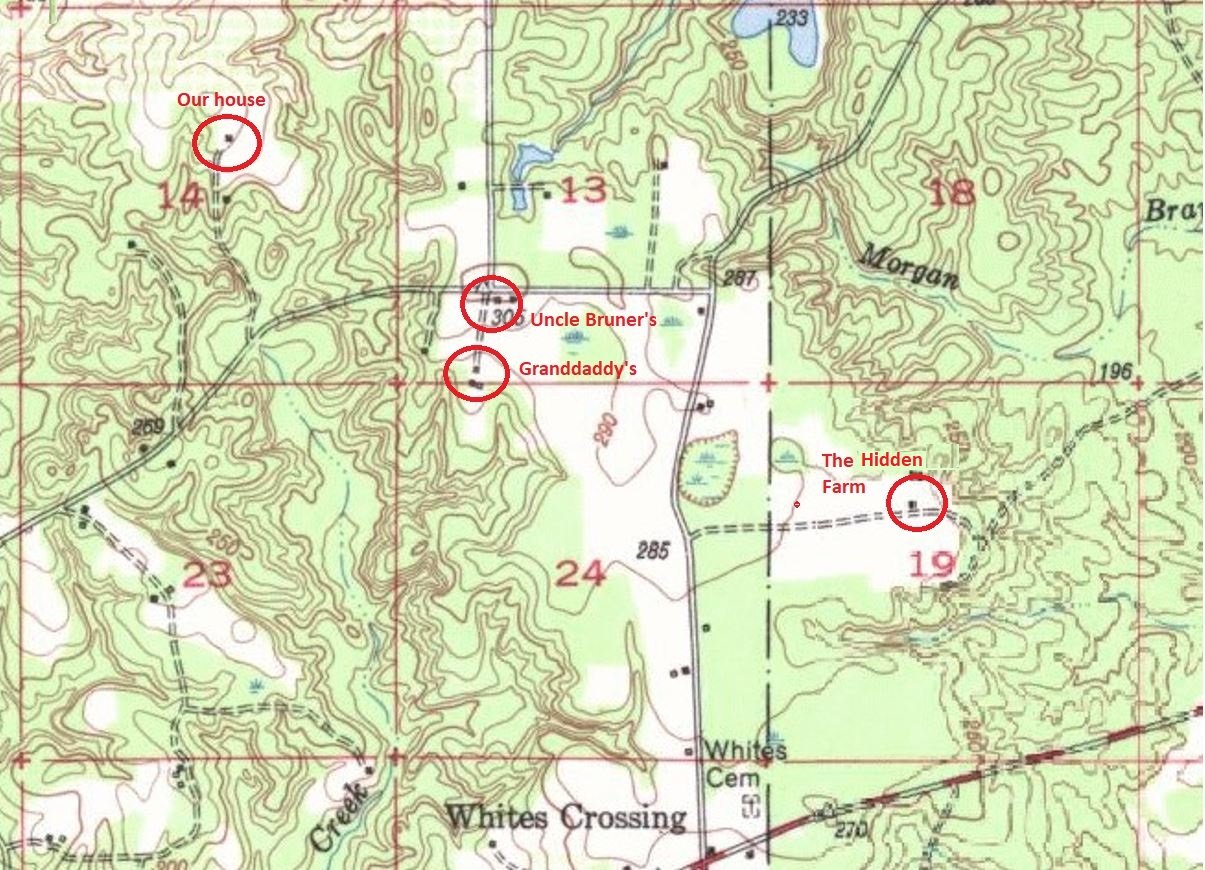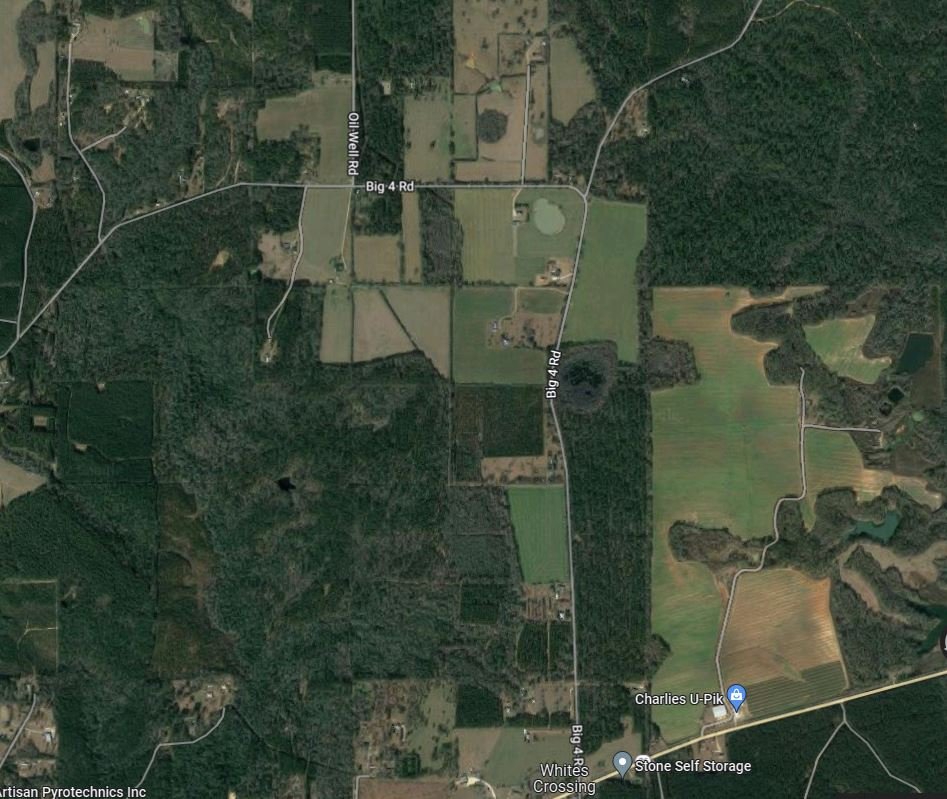The Hidden Farm
It was June—heck, it could’ve been the third of June. Whether it was or not, it was just another sleepy, dusty Big Level day. I was almost 7 years old, I think, so it must have been around 1959. Daddy had been in from work for a couple of hours. Mama and Judy had already cleared the supper dishes. Keith and I were in the yard playing catch. John was . . . well, I don’t remember what my younger brother was doing—something mischievous, no doubt. Daddy had finished a couple of farm chores and had washed up again. And now he and Mama were settled on the back porch with a cup of coffee enjoying the remains of this typical early summer evening while watching us young’uns playing in the twilight.
I don’t know who saw it first, probably Daddy. To the southeast, in the direction of Uncle Bruner’s and Granddaddy’s places, there was dark smoke billowing above the trees. It had come up fast and was getting larger. I thought that someone may have been burning a large brush pile, but Daddy quickly pointed out that the smoke was too dark to be just a trash or woods fire. He was of the opinion that someone’s barn or house was on fire. We asked if it could it be Granddaddy’s, but he assured us that it seemed to be farther away than that. However, he said that he should go check it out. So, without delay, he handed his coffee cup to Mama and started for the pickup. Keith and I were right behind him. “Okay, boys,” he said, “You can go, too. Hop in.”
As we neared Uncle Bruner’s house and got to the top of the rise, we could see that the fire—actual flames were now visible—was still about a mile away. We continued to drive down the recently paved Big Four Road on around towards White’s Crossing. When we reached a spot that had a a thick stand of pines and hardwoods, we turned left onto a small lane.
I’d never paid any attention to this road and I pretty sure I’d never been down it before. I assumed it was just another old logging road, as were so common in the area. After we had gone a few hundred yards down this little two-path lane, an unexpected vista magically appeared before my eyes. To my surprise, there was a large open pasture on one side of the lane and an even larger cornfield on the other. True to our community’s name, these fields were as flat as any in Big Level. Between the fields sat a barn with a large shed attached and a two-story farmhouse. And each of these frame structures was fully ablaze. I was transfixed by the sight.
A portion of upper Big Level from a 1947 USGS topological map with my annotations showing the hidden farm in relation to our place.
By the time we neared this inferno, we could see that these buildings were so far gone that there was nothing to be done but to watch them burn. We parked some 50-75 yards away with the others who were arriving—any closer and the heat would have been unbearable. Most everyone stayed in their vehicle to witness this spectacularly tragic event. The roof of the barn was the first to collapse. A few moments later, the house fell in, too, with each falling timber shooting streams of embers high into the now fully-dark sky.
Daddy and a few of the menfolk then gathered to try to ascertain what had happened, but there seemed to me to be more questions than answers. I knew pretty much only what I could see: The Forestry Service had plowed a firebreak around house and barnyard to prevent a grass fire from spreading. A tractor and corn conveyor and a few other pieces of farm equipment had been driven or pulled out from under the shed to safety. It was also apparent that trying to get a pumper firetruck to come all the way out from Wiggins would have been pointless. Even at my young age, I knew that would’ve been much too little and much too late to have made a difference. When Daddy returned to the truck, he told us that the cause of the fire was unclear, but that it probably started in the house. He said that no one was hurt and that a handful of personal items from the house had been saved, though not much else. With that we drove back home.
I was astonished that I’d been down that stretch of road hundreds of times without knowing or even suspecting that only two miles from our house there was such a large farm lying out of sight less than a quarter of mile through the trees lining that lane. No one that I could recall had ever mentioned it, not Daddy or Granddaddy. How did that fact get by me? Who were these people? And what was the history of this beautiful place that was now just a pile of ash and embers?
Daddy knew them, of course, and I’m sure he told me their name, but that’s a detail that didn’t stick with me. And here, decades later, I realize that I never thought to ask again about this or any of a few other details that would flesh out this story. Now it’s almost like it never happened. I checked with my brothers, but they didn’t remember much, neither did my cousins Mike and Jerry when I called them about it. Like me, they still carry a vague recall of the place but aren’t able to reach back and dig out a name to go with it. But just yesterday, Mike called me back to say that he’d bumped into Roger White and had asked him what he knew about the place.
Roger, of the Whites of White’s Crossing, would have been a teenager at the time and his family was one of the closest neighbors to this farm. He believes the place was a part of a full section of land, 640 acres, that was originally owned by two Hatten brothers, Wade and his younger brother Norman, both born in the 1800s. These are names I recognized, as they are in my genealogy files, distant cousins appearing in both the paternal and maternal branches of my family tree. According to Roger, various smaller parcels of this large tract were sold off over the years and the land in question eventually came into the possession of a Knight family who owned or was renting it at the time of the fire.
That fits nicely with what I’d already learned. In talking with my brothers and cousins, mention of the “old Knight place” came up a few times, but no one could pin it down as being this farm or one of the other old homesteads around the area. However, all agree that the place was effectively abandoned after the fire and no one ever built the farm back to its former glory. A few years afterwards, that prime acreage was absorbed back into a larger tract stretching down to Highway 26 that was operated through the ’60s and ’70s as a Del Monte tomato farm. Then, after changing hands a few more times, this property recently became a u-pick vegetable farm.
A satellite image from Google Maps showing this tract of land today. The hidden farm would have been located on the north end of the Charlie’s U-Pik property on the image right.
Today the little lane is grown over and there’s nothing left to indicate that anyone ever lived on that tucked-away farm. Unlike those spots you occasionally see where a few large lone-wolf shade trees stand as sentinels out on the edge of a field, with small clusters of daffodils around them springing up to proclaim that this used to be an old homeplace, maybe a 100 or 150 years ago, reminding us that some long-ago pioneer wife planted those trumpet-shaped yellow flowers and that a generation or two or three of daughters and daughters-in-law tended and enjoyed them over the years as they and their families worked and made their livelihood on the land. I’m sure you’ve seen such spots.
Contemplating that old farm now, after the passage of some 60-odd years, it saddens me to think that I’m one of just a few people left who still retains a living memory of that magical place—tucked, as it was, back in the woods away from the bustle of life going on around it. Even fewer of us witnessed that tragic fire that took it away so suddenly. In a few more short years, who’s going to know what happened or that it was ever there? That saddens me even more and it compels me to want to write this and similar stories.
Maybe one day some family will reclaim this old homeplace, so that once again there will appear cornfields and cow pastures, a house and barn, and maybe a few daffodils, to surprise and enchant a young boy making his first trip down that tree-lined lane.
A Term TO PONDER
Wolf tree: A “wolf tree” isn’t a species, rather the term refers to a tree that is something of a “lone wolf” among its peers. When an oak or other large shade tree is growing in a rural yard, it often has only one or two nearby competitors around a home or barn. Other trees are cleared for the yard or field so that there is an obvious distinction between those lone trees and the forest that outlies them. Once the house and outbuildings are abandoned or removed, and the forest is allowed to reclaim the land, other trees return. However, those one-time-shade trees will often still stand, spread out and larger than the rest, and you know just by looking at them that if they could talk you’d have quite the story. [From “Wild Plants and Historic Archaeology,” an article in Archaeology Review, 3 Apr 2018]
SONG OF THE DAY
“Something's Burning” by Kenny Roger's & The First Edition (Something's Burning, 1970)

